Sarah Emsley's Blog, page 15
March 24, 2023
“The writing of sponge-cakes”
“I’m that person who finds the purchase of a sponge-cake to be delightful.” I’m quoting Shawna Lemay, whose novel Everything Affects Everyone I wrote about last Friday. I enjoyed the novel so much that I’ve been reading more of her work, including some of her poems, and a splendid essay I remembered from a few years ago, called “The Sponge-Cake Model of Friendship.”
“You know how interesting the purchase of a sponge-cake is to me,” Jane Austen wrote to her sister Cassandra on June 17, 1808.

Shawna says, “I find it diverting to know what my friends had for breakfast, where they hope to holiday, that they enjoyed a scone with plum jam, a piece of chocolate cake, or sour cherry pie, or that they purchased a new scarf. Friendship is in the details, I’ve discovered.” She writes of Jane and Cassandra that “The two sisters were often enough separated, and it’s the writing of sponge-cakes to each other that comforts, that makes each feel less alone.”
She considers other types of friendship before returning to “the Jane and Cassandra model,” which is “one of mutual interestedness,” and concluding that this is her “only requirement in friendship.”
You can find details about Shawna’s other books on her website. I remember that I loved her novel Rumi and the Red Handbag (and not just because Jane Austen’s line about sponge-cakes makes an appearance in the book, or because it includes a character who follows the careers of stars who’ve appeared in movie adaptations of Austen’s novels: “I want to see if they go on being anything like the characters they portrayed. … I keep lists on them, she said,—see, Ciaran Hinds, Colin Firth, Jeremy Northam, Hugh Grant, Jonny Lee Miller, especially him. Really, I’d like to make a movie with just them and scratch the heroines, you know? A movie about their lives after Austen, a documentary.”)

I also recommend Shawna’s collection of short essays entitled The Flower Can Always Be Changing—the title is a quotation from Virginia Woolf—and I’m a long-time fan of her blog, Transactions with Beauty.
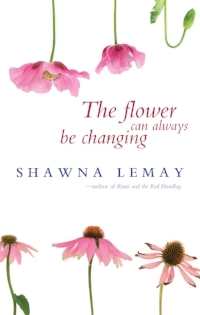
Letters and FaceTime calls have been a comfort to my sister Bethie and me during the years that she and her family have lived on the other side of the Atlantic. I’m pretty sure she’d agree with me that, to borrow Shawna’s words, “the simple daily pleasure of just delighting in each other’s ordinary lives is and has been magnificently sustaining.” We often send photos of our children, or trees and flowers, or the books we’re reading.
Or cake! My daughter likes to make and decorate cakes: one of last year’s creations was a Ron Weasley cake for one of her younger cousins; this year she’s been hired to design an Anne of Green Gables cake for one of our friends. Bethie has (in my opinion) perfected the art of making gluten-free birthday cakes, including carrot cake with cream cheese icing and ginger cake with a chocolate glaze and sprinkles. She and I also exchange books. Or other small presents—this week, for example, I sent her a Squishmallow avocado. Not nearly as elegant as an Austenian sponge-cake, but still a source of amusement and comfort for both of us. (As it happens, the label says the avocado’s name is “Austin,” though that isn’t why I bought it.)
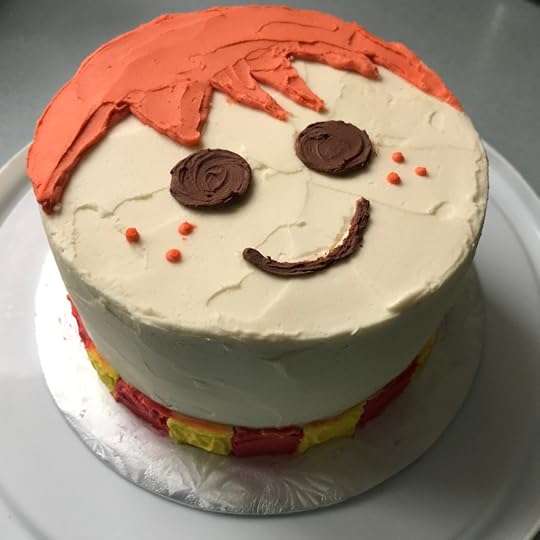

After I wrote earlier this month about how much I loved Heidi L.M. Jacobs’s novel Molly of the Mall, and about my plan to read L.M. Montgomery’s Jane of Lantern Hill in May, Bethie decided to order copies of both novels, and when they arrived, she sent me a photo with this note: “Inspired by the way you photograph books on top of lovely scarves, I have artfully arranged these on top of this pile of unfolded laundry : )”
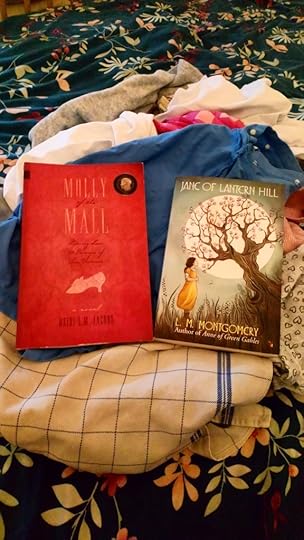
Bethie and I have also corresponded recently about the news that Ann Napolitano’s new novel, Hello Beautiful, has been chosen for Oprah’s book club, and about an essay Napolitano wrote for the New York Times a few years ago, in which she talks about letters she’s written to her future self. “I wrote the first letter when I was 14,” she says, “and I stole the idea from a novel.” I bet many of you will know which novel she’s talking about.
In L.M. Montgomery’s Emily Climbs, Emily Starr writes a letter on May 19th, 19 – :
This is my birthday. I am fourteen years old today. I wrote a letter “From myself at fourteen to myself at twenty-four,” and sealed it up and put it away in my cupboard, to be opened on my twenty-fourth birthday. I made some predictions in it. I wonder if they will come to pass when I open it.
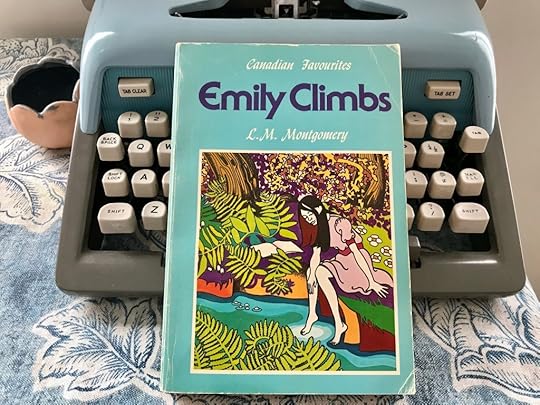
Napolitano says, “the idea of the letter delighted me. It was a grand gesture, yet of the kind an introverted kid could make alone, with no one noticing. I described the current state of my life and listed my hopes and dreams for myself 10 years later.”
Were any of you inspired to do something similar after reading Emily Climbs? I was. I wrote, “To 19 from 9. Have you written your great book yet?” My goal at the time was to write and publish my first book within the next few years, following in the footsteps of Gordon Korman, who wrote This Can’t Be Happening at Macdonald Hall when he was 12, and signed a contract to publish it with Scholastic when he was 13.

That was a lot of pressure for a nine-year-old to put on her future self! Fortunately, that letter also said, “Please be kind 19. Love 9.” I hope my nine-year-old self would be pleased to know that I’ve published five books in the three decades since I turned 19. (I don’t know whether she’d think they’re “great” or not.)
Bethie also wrote a letter to her future self—and I don’t think either of us knew the other had done this until we started talking about Ann Napolitano’s essay.
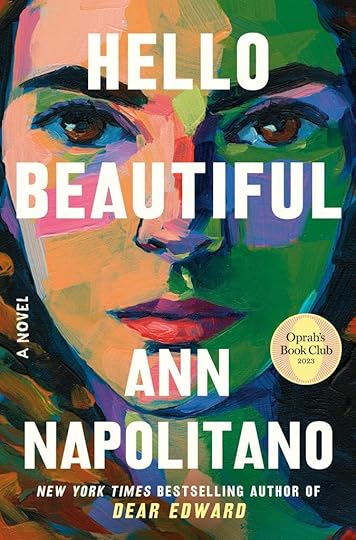
When I was searching for the photos I took at the Carol Shields Memorial Labyrinth, to include in last week’s blog post, I also came across a couple of photos of the Bookmark plaque for Shields’s novel The Republic of Love, which my family and I visited on that same trip to Winnipeg in 2016. (Actually, it was a drive from Halifax to Vancouver and home again, with a stop in Winnipeg on the way out west. The post featuring photos from that road trip across Canada and back through the United States continues to be one of the most popular on my blog.)

For the past eight or nine years, I’ve been volunteering with Project Bookmark Canada, to help choose passages from fiction and poetry set in specific places, which can be marked with a Bookmark plaque. Most of the time, other kinds of plaques commemorate sites where real events happened. What I love about Bookmark plaques is that they mark sites where the things that “happened” are in the imagination of the writer, and then of the reader.
Our local Nova Scotia Reading Circle for Project Bookmark has organized events in Halifax to celebrate the unveiling of a Bookmark in Port Hastings, NS, for Alistair MacLeod’s extraordinary novel No Great Mischief (which won the IMPAC Dublin Literary Award in 2001), and for the unveiling of a Bookmark plaque in Cavendish, PEI, for L.M. Montgomery’s poem “The Gable Window.”


I stopped to take pictures of lupines when I was on my way to the unveiling of the Bookmark for “The Gable Window” in June of 2018.

I took another picture of the Montgomery Bookmark in October of 2019, when I was in PEI for a wedding.
I was delighted to visit the Bookmark for The Republic of Love, which is at “the bus shelter at River and Osborne” where Shields’s heroine Fay sometimes “wait[s] anonymously” and sometimes “run[s] into any number of acquaintances.” In Winnipeg, “You were always running into someone you’ve gone to school with or someone whose uncle worked with someone else’s father. The tentacles of connection were long, complex, and full of the bitter or amusing ironies that characterize blood families.” While some find the connections oppressive, “Fay again and again is reassured and comforted to be part of a knowable network.”


(I have to confess here that I haven’t yet visited the No Great Mischief Bookmark, even though I love that novel and the Bookmark is in my own province. Someday!)
I want to add a few more things to this week’s scrapbook. First, a link to a CBC Radio documentary about the recent celebration of Mi’kmaq Poet Laureate Rita Joe at the Halifax Central Library and the Millbrook Cultural Centre, organized by the Afterwords Literary Festival and hosted by Mercedes Peters. I attended the event at the Central Library last month, and I enjoyed the readings and music, which were by Tiffany Morris, Danica Roache, and Raymond Sewell.
Rita Joe writes in her autobiography, Song of Rita Joe, that “I have said again and again that our history would be different if it had been expressed by us.” She tells her readers that “Being strangers in our own land is a sad story, but, if we can speak, we may turn this story around.”
I loved hearing Raymond Sewell speak in the documentary about how his father, “a respected elder in the area, was always telling us ‘Rita Joe said we’re from the land of the dreamers, we’re a dreaming people, be creative.’ We were all dreaming at home, there was an endless supply of art supplies at home, so some people were drawing, some people were making music in the basement. My father always had instruments around, my mother always had instruments around that we could play. We’ve always had a need to carry on stories.”
Rita Joe was the 2023 honouree for Nova Scotia Heritage Day, and if you’d like to read more about her life and her poetry, you can find out more in this blog post from Halifax Public Libraries.
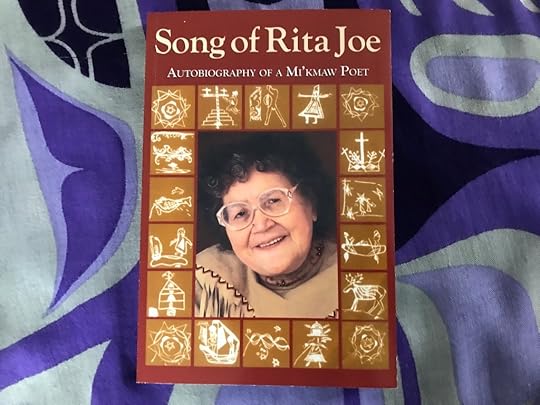
Next, I want to tell you about this lovely survey of marginalia over the years, by Jillian Hess: “Marginalia: 5 Ways to Write in Your Books.” She gives examples from 1300 to 2022, including the symbols used by Samuel Taylor Coleridge, comments both positive and negative recorded by medieval readers (“Thys ys a Good Boke Amen”; “Whoever translated these Gospels, did a very poor job”), and photos of conversations among different readers.
Do you write in your books? I do. I could write more on this topic, but maybe I’ll save it for another day.
I also want to include a few of Brenda Barry’s photos, this time from Margaretsville, Nova Scotia—the wharf and lighthouse, a chickadee, and Isle Haute—sent to me by her sister Sandra, who writes that the lighthouse reminds her of the one in Elizabeth Bishop’s poem “Seascape.” Sandra says the lighthouse in the poem is “severe,” while “the one in Margaretsville seems more cheerful,” but Bishop’s “description echoes this one.”
… a skeletal lighthouse standing there
in black and white clerical dress,
who lives on his nerves, thinks he knows better.
He thinks that hell rages below his iron feet,
that that is why the shallow water is so warm,
and he knows that heaven is not like this.

I’m grateful to Sandra and Brenda for the wonderful letters and photos (sponge-cakes!!) they send, and for giving me permission to share these images with you here.


An exhibition entitled “My dear Cassandra…” opened earlier this week at Jane Austen’s House Museum, and it includes a recently acquired letter from Jane to Cassandra, dated October 27-28, 1798. Jane begins by saying, “Your letter was a most agreable surprize to me to day, & I have taken a long sheet of paper to shew my Gratitude.” She speaks of her mother’s illness and her new role in managing the household:
I am very grand indeed; I had the dignity of dropping out my mother’s Laudanum last night, I carry about the keys of the Wine & Closet; & twice since I began this letter, have had orders to give in the Kitchen: Our dinner was very good yesterday, & the Chicken boiled perfectly tender; therefore I shall not be obliged to dismiss Nanny on that account.
This is also the letter in which she tells Cassandra the news that “Mrs Hall of Sherbourn was brought to bed yesterday of a dead child, some weeks before she expected, oweing to a fright,” and makes the uncharitable and now infamous remark that “I suppose she happened unawares to look at her husband.”
“Newly Acquired Austen Letter on Display”
“Rare early letter from Jane Austen to her sister will go on public display”
I’ll end with a recent photo of the view from the café on the top floor of our beloved Halifax Central Library, and a photo of snowdrops in yesterday afternoon’s snow.

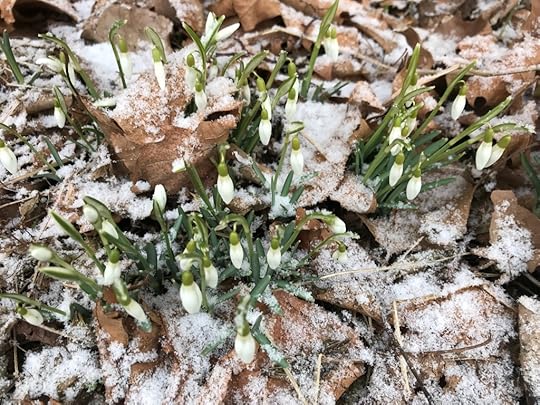
Thank you, as always, for reading.
If you enjoyed this post, please consider forwarding it to a friend and/or joining the conversation in the comments.
You can also find me on Facebook, Twitter, and Goodreads. I’ve had an Instagram account for years, though I haven’t yet posted anything—not sure why, since I love sharing photos and seeing what friends have posted. Come and find me there, too, if you’re so inclined.
March 17, 2023
“Secrets that everyone knows”
“Reality is full of secrets that everyone knows and refuses to acknowledge,” says Xaviere in Shawna Lemay’s novel Everything Affects Everyone. I had been reading the book earlier this month (as I mentioned here a couple of weeks ago), and I was reading slowly, savouring lines like this one and copying out quotations I wanted to remember.
In an interview with Xaviere’s friend Daphne, the photographer Irene Guernsey speaks about creating art: “There is above all a sacredness in creating something from nothing.” She says, “Art, itself, can bear quite a lot, and it can be enough, or close to enough.” It can be made in “isolated spots.” It doesn’t necessarily have to be noticed. The artist has to “be able to feel, to let things in.” And yet “The world is always at odds with the artist,” and “Maybe it has to be that way.” I liked finding Rilke in this novel: “You must change your life,” he says, and the women of Everything Affects Everyone recognize that they are all engaged in a process of transformation, as they work to understand the mysteries of art.
As I say, I had been reading the novel slowly, and then, last Friday, after I received news of the death of a family friend, someone I had known and loved all my life, I struggled to make sense of the shock and one of the first things I did was to curl up with Shawna’s novel and read the rest of it all at once. I suppose in a way I was trying to find out how this thing that had happened would affect all of us, everyone. Each loss is unique, of course, and yet all of us experience loss again and again, as we lose people we love, dreams we once cherished, visions of what might have been.


The Carol Shields Memorial Labyrinth in Winnipeg, Manitoba, which my family and I visited on a warm, sunny morning in late June of 2016 with our dear friend, who had lived in Winnipeg for many years.
Reading didn’t take away the pain, though I don’t think that’s the effect I was searching for. Like Xaviere, I felt I was learning that “I’m meant to breathe and live, and beyond that, I’m meant to appreciate the beauty of things in a heightened way.” I went looking for photos of the friend we had lost, and I found one—the last photo of her that I took during what turned out to be her last visit to Halifax—in which she is laughing, during a conversation with one of my aunts, and I could almost hear that familiar laugh. For a moment, she was with us again.


Quotations from Carol Shields

I won’t try to summarize the plot of Shawna’s beautiful novel. Indeed, as Xaviere says, her life “is to be without plot.” Things do happen in this book: transformation—even transfiguration—and theft, and reconciliation. But the plot isn’t the main point. A photograph stolen from an exhibition in Edmonton, Alberta called Snow Angels, Forgotten Angels, and Winged Beings is linked with the artworks stolen from the Isabella Stewart Gardner Museum in Boston on March 18, 1990. Something about the empty frames that mark the locations of the crimes prompts people to talk about other things that have been stolen or lost.

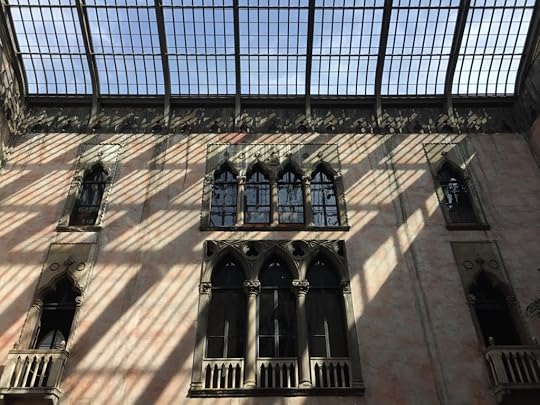

The courtyard at the Isabella Stewart Gardner Museum, which I visited often during the years I lived in Boston and Cambridge. These photos are from a family holiday in 2017, several years after we had moved back to Canada. We spent a week with my sister Bethie and her family, just before they moved from Boston to Bonn.
Everything Affects Everyone draws attention to “the sense that there are no endings.” Beyond the “traditional narrative arc,” says a character named Michelangelo Dupree near the end of the novel, “There is an ongoingness that I wish to capture.” And maybe that’s the word I was looking for when I read Shawna’s book last Friday afternoon: ongoingness.
I often find myself quoting Aristotle, who says in the Nicomachean Ethics that “The things we have to learn before we can do them, we learn by doing them.” I heard an echo of this idea in Xaviere’s claim that “I need to know things that I will only learn by knowing them.” Practice. Education. Creativity. All of us know secrets about loss. Sometimes we can look at them and sometimes we can’t. Even when the frame is empty, maybe we can create something from nothing. Learn something by doing it. Know something by knowing it. Learn to grieve by grieving.

Snowshoeing in Kingston, Nova Scotia (sent by my friend Sandra, and taken by her sister Brenda)


Photos from Banff, Alberta, sent by my brother, Tom



Photos from Hawaii, sent by my sister Edie

My mother’s orchids



Photos from my recent walk with friends, and our dogs, at Fort Needham, in Halifax
March 10, 2023
The Last Phone Booth
When I read about the “world’s smallest Austen museum” in a red telephone box in Steventon, Hampshire, in a recent Atlas Obscura piece, I could almost hear Joel Plaskett singing “I am standing in The Last Phone Booth on The Planet Earth / Just trying to get an operator / Please connect me now to anyone.”

This red telephone box is obviously not the one in Hampshire. It’s in Nova Scotia’s Gaspereau Valley, at Luckett Vineyards. I added a digital frame as part of an assignment for an online photography class I took several years ago (taught by the always-inspiring Joy Sussman of Joyfully Green).
I took another photo from the same spot during the Jane Austen Society (UK) conference that was held in Halifax in June of 2017. Following lunch at the vineyard, our group visited the memorial church and the statue of Evangeline at Grand Pré National Historic Site.

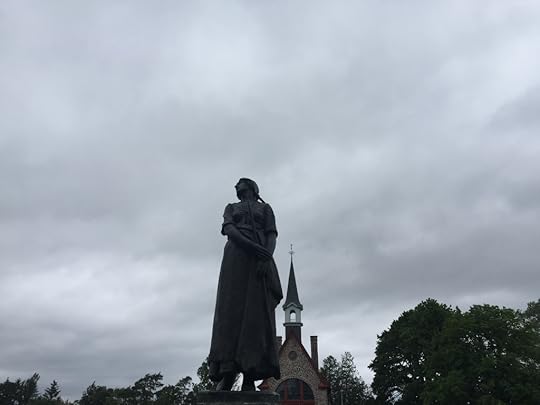
The telephone box Jane Austen museum also functions as a book exchange, like a Little Free Library, or the book stalls in Bonn that my sister Bethie checks regularly to look for English books.
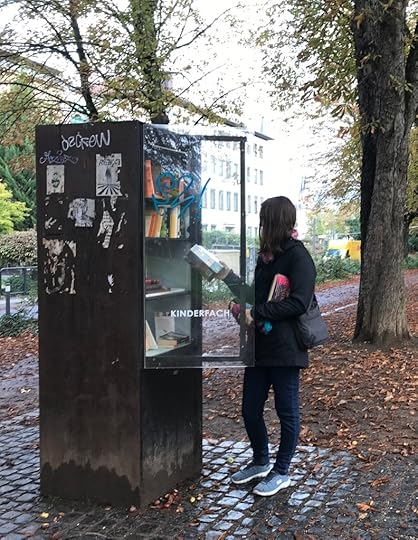


She recently found two different editions of Tom Jones, which she took as a sign that she should read it right away, and she loved it. She sent me a photo of a few of her treasures. The most unusual book she’s discovered there is a German cookbook featuring recipes from ancient Rome, which appealed to her because she’s a Classics scholar.


A few more things for this week’s “scrapbook”:
First, a blog post by Donna M. Campbell: “First Edition of The House of Mirth: A Literary/Bibliographical Mystery.”
Did you know that Edith Wharton hated the illustrations for this novel so much that she tore them out and crossed out the illustrator’s name?? I didn’t (or if I did, I had forgotten).
The mystery has to do with whether the first edition, first printing of The House of Mirth is the one without ads or the one with ads included on pages 535-38.
I own two early editions of the novel, both published by Scribner’s, one in 1905 and the other in 1931. The 1905 edition includes the ads, which—I think, based on what Donna says in her blog post—means it may be the first edition, first printing. The 1931 edition used to belong to the library of Leverett House, Harvard University. The cloth on the spine is torn and the book has been mended in a few places. Fortunately, the 1905 edition is much better condition.

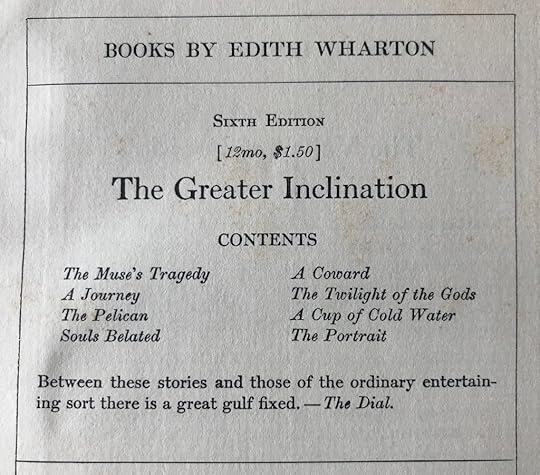


If this were a real scrapbook, I might be tempted to affix this adorable origami frog—made by the sister of one of my friends, who enclosed it with a card she sent me a few days ago (hello and thank you, Sandra and Brenda!)—to one of the pages. But then my family and I wouldn’t be able to press on its back to make it leap across our dining room table. So I’ll just include a photo here, and leave it free to keep moving.
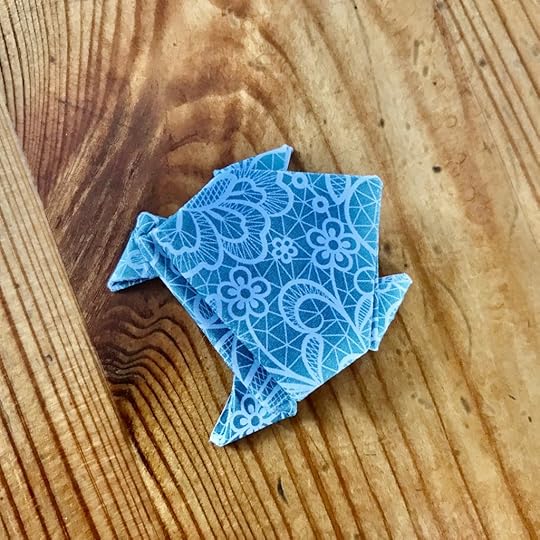
Here are some photos from a hike with friends last Sunday, on the snowy trails at Long Lake. Whenever I see that bright blue sky, I’m tempted to take lots of pictures. On this occasion I managed to snap only a few, however, because I spent much of the time trying to prevent our dog from running out onto the ice, just in case it isn’t frozen solid anymore.



Halifax, as seen from the Dartmouth waterfront on Sunday evening:

On Monday, the clouds had returned. When I went downtown for an appointment that afternoon, I took a couple of pictures of the Old Burying Ground, which served as the inspiration for “Old St. John’s Graveyard” in L.M. Montgomery’s Anne of the Island.
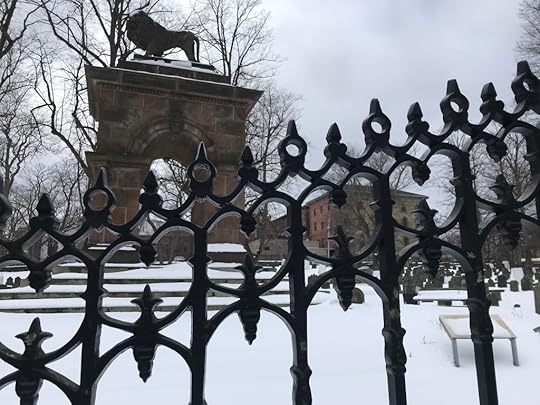

“I don’t know that a graveyard is a very good place to go to get cheered up, but it seems the only get-at-able place where there are trees, and trees I must have. I’ll sit on one of those old slabs and shut my eyes and imagine I’m in the Avonlea woods.”
– Anne Shirley
On Tuesday evening, I visited the Truro Library, to hear Alexander MacLeod read from his brilliant short story collection Animal Person. If you’re interested, you can listen to him read his story “Once Removed,” which was published in the New Yorker last year.
I tried to capture the lights on the trees next to the library, and this is what I ended up with:

It isn’t what I expected, but I like it even more this way, so I’ll keep it.
Here are a couple of things linked to last week’s post, “Oh, novels! What would I do without you?”
I found photos of the second Regency gown I made for my daughter. Here she is at age nine, when we attended the JASNA AGM in Washington, DC:
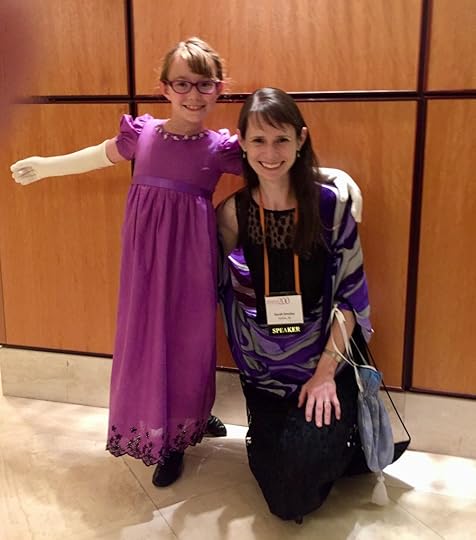

And here’s a link to The Next Chapter on CBC Radio, where you can listen to Heidi L.M. Jacobs talking about her novel Molly of the Mall: “Heidi L.M. Jacobs’s novel Molly of the Mall is a charming look at life in Edmonton.”
“It’s a book about finding out who you are by navigating where you’re from and also about finding the beautiful and the poetic in wherever you live. But I think at its core it’s really about how books help us learn who we are and about how books help us find a space and a place and a voice in the world.”
I’ll say goodbye for now and leave you with this photo of two parrots, a fox, and a dragon, created and photographed by Brenda Barry of Triad Photography. Thanks for reading, and I hope you have a pleasant weekend.
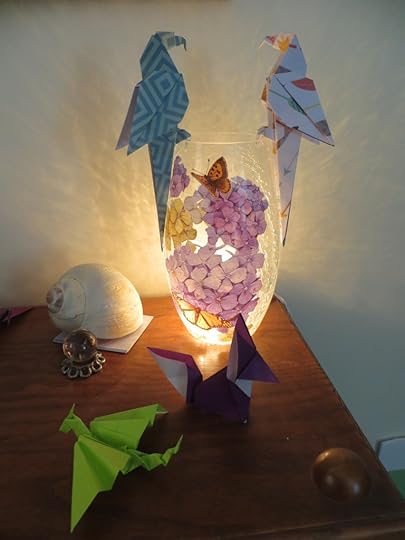
March 3, 2023
“Oh, novels! What would I do without you?”
Let’s read Jane of Lantern Hill! Thanks to everyone who commented—here, on social media, in letters and emails, and in person—in response to last week’s post about Reading L.M. Montgomery Together. Based on the responses we received, Naomi and I have decided to read Jane of Lantern Hill this spring, and we hope you’ll join the conversation. We’re planning to write about the novel in May. (And maybe we’ll turn to Kilmeny and/or Pat later on. We also took note of the votes for Rilla and Emily. Thank you for your enthusiastic response to all these books!)

If you’re interested, you might like to subscribe to Naomi’s blog, Consumed By Ink, as well as mine. We’ll link to each other’s posts about the novel, and to posts by others, too, so please do send us details and links if you decide to write about your experience of reading/rereading the novel. Let’s use #ReadingLanternHill as our hashtag.
My title for today’s post comes from Molly of the Mall, by Heidi L.M. Jacobs, rather than from Jane of Lantern Hill. More on Molly below—for now I’ll just say that I think she and L.M. Montgomery’s heroines would be kindred spirits.
So far, I’ve read the first chapter of Jane of Lantern Hill, and I’m keen to read more, about the huge brick house on Gay Street with its “towers and turrets wherever a tower or turret could be wedged in,” and gates “that were always closed and locked” at night, “giving Jane a very nasty feeling that she was a prisoner being locked in.” I want to learn more about Jane, who knows very clearly that her name is Jane even though everybody calls her Victoria. Even her mother calls her Jane Victoria. I know I read the novel when I was ten or eleven, but I don’t think I’ve read it since then, and I’ve forgotten almost everything, aside from a vague sense of having loved it a great deal, in the same way that I loved nearly all of Montgomery’s books (aside from Anne of Windy Poplars, which I didn’t like back then, and didn’t like when I reread it a few years ago).
Have any of you seen the 1990 film adaptation of Jane of Lantern Hill, starring Mairon Bennett, Sam Waterston, and Sarah Polley? I haven’t (yet). Maybe we could discuss it as well, in May.
Inspired by L.M. Montgomery, I’m still working (as I mentioned last week) with the idea that my blog is a kind of scrapbook. Here are a few things I’d like to “paste” in to share with you.
First, a blog post by Shawna Lemay on how to “re-frame, retrain our brains, how to shift or jostle or shine up our thinking.” Her blog, “Transactions with Beauty,” is always inspiring, and I’ve long admired her work as a photographer, poet, and novelist. We knew each other many years ago when we were both undergraduates in the Honors English program at the University of Alberta, and it’s been wonderful to reconnect with her online over the past several years. I’m reading her novel Everything Affects Everyone right now and I love it. I’ll probably write about it in more detail here once I’ve finished it. I agree whole-heartedly with what Shawna says in this post from last week about a key source of creative inspiration:
“I myself think a relatively easy shortcut to changing or enlivening our thinking is pretty much always going to be: read more poetry.”
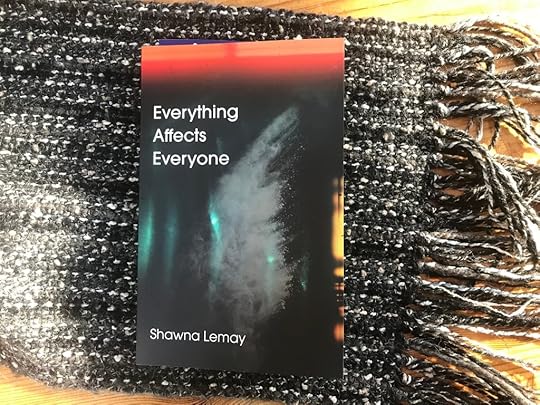
I chose this scarf for the background because it was a gift from a friend who lives in Edmonton, and because in the opening paragraph of the novel, the narrator, Xaviere, speaks of choosing to wear a scarf she could imagine her friend Daphne “reaching over and touching—she’d have admired the texture and colours and would have leaned over and delicately fingered the knotted fringe.”
Sticking with an Alberta theme, and the topic of handmade scarves, I want to share this lovely piece by Angela of Neatnik Yarns, in Edmonton, Alberta, called “Making Things to Feel Better.” It’s from the winter of 2021, written in an earlier stage of the pandemic, but I discovered her website only a few days ago, and I think what she says about the healing power of making things with our hands is just as true now as it was then. She writes that for many, “the attention required while we make these things results in a sort of meditative state,” and that “the fibre arts provide both tactile and mental comfort.”
One of my accomplishments over the first couple of years of the pandemic was that I finally completed a cross-stitch kit I had purchased in the gift shop of the Bodleian Library in 2002, with the goal of giving the finished product to my mother for Mother’s Day that year. It was a glasses case, with a pattern based on a design of strawberries and flowers embroidered for Queen Victoria by her mother. This was only the second cross-stitch project I had ever attempted in my life, and I worked on it a little at a time year after year. Last winter, I finally finished it, and I presented it to my mother as a very belated Mother’s Day 2002 present. I guess I could have said it was a few months early for Mother’s Day 2022, but I stuck to the truth.

After I had completed that project, my daughter and I spent several pleasant hours last winter working on rug hooking kits we had purchased in the summer of 2021 from Deanne Fitzpatrick’s studio in Amherst, Nova Scotia. My daughter worked quickly, and completed her Wild Rose Field within a couple of days. It took me longer to complete my Lost Sheep kit—about a week—but I must say, it was tremendously satisfying to complete a kit in under twenty years. My daughter gave the wild roses to me, and I gave the sheep to her. We haven’t framed them yet, and for now, they’re on display in our kitchen, hanging from a curtain rod we’ve used for years as a place to display drawings and paintings, or Christmas ornaments. I like them this way, with the titles visible.

It was fun to try something new. I’ve worked on many sewing projects over the years, including two Regency gowns for my daughter, who wore them at JASNA (Jane Austen Society of North America) conferences we attended together. I enjoyed my experiments with both cross-stitch and rug hooking, and I agree with what Angela says about how the act of working with our hands on projects like these can provide comfort during challenging times. Deanne Fitzpatrick says something similar about rug hooking, which can be “joyful, powerful and transformative.” I felt grateful to be able to create something small, something beautiful, to give as a gift to someone I love, regardless of how long it took to make it.
Here’s a photo of my daughter in the gown she wore for the Regency Ball at the JASNA AGM in Montreal, in 2014 (shared here with her permission):

Another addition to my scrapbook, again with a connection to my Alberta theme: I want to recommend Molly of the Mall: Literary Lass and Purveyor of Fine Footwear, by Heidi L.M. Jacobs, which I finished reading yesterday. I’m not sure how I missed this book when it came out in 2019, but I’m delighted to have found it at last, thanks to Naomi. (If you’ve read the last few posts on my blog, you’ll know already that Naomi is an excellent source for book recommendations.) I’m rarely up to the minute on book news—usually I’m somewhere in the 19th Century, instead of the 21st—and I like tracing the often-circuitous routes through which I make new discoveries.
I absolutely loved Molly of the Mall, and not just because it took me right back to the early nineties, when I, like the fictional Molly (and my friend Shawna, as mentioned above), was an English major at the University of Alberta. I also, again like Molly, worked in a mall in Edmonton, although in my case it was a fabric store in Kingsway Mall, rather than a shoe store in West Edmonton Mall. And I visited the same cafés and bars on Whyte Avenue and the U of A campus, including Java Jive and Dewey’s.

The silk scarf in the background was a gift from our family’s dear friend Janet. My parents met her in Edmonton when they were graduate students.
The view from my dorm room in my first year at the U of A:

Kerry Clare says in her review that she is “besotted” by Molly of the Mall, and while she acknowledges that it might not be for everyone, “if you came of age in the 1990s, worked in a shopping mall, longed for a literary life, ever felt a bit weird about your dad’s devotion to Robbie Burns, dreamed of a romance that was swoon-worthy, felt confused in university English classes, and let 19th century novels play perhaps too great a role in informing your perspective on … everything—then you will not be sorry.”
Edmonton in the summer of 1991:


Sometimes I actually felt as if I were reading about my own life as the child of graduate students in the English Department at the University of Alberta. I thought of my own first name when Molly, who is named for Moll Flanders (and whose siblings are named Tess and Heathcliff), says that “The next generation of departmental children had solid Old Testament names.” When I read about Molly’s mother defending her master’s thesis on Botticelli just two days before Molly was born, I thought of my mother defending her master’s thesis on Malcolm Lowry’s novel Under the Volcano less than a month before I was born.
Like Molly, I have wondered “why there are no lovely poems about Edmonton.” (The only Edmonton poem I can think of at the moment is the one by Margaret Atwood that begins “So this is it / flat Edmonton….”) Molly remembers imagining that by the time she turned twenty, she’d be living “like one of Mum and Dad’s grad-student friends in one of those walk-up apartments off Whyte Avenue with misleadingly elegant names like The Alhambra or The Loch Lomond”; when I was nineteen, I sublet a friend’s apartment in one of those buildings, which—coincidentally—was the same one my parents had lived in when they were graduate students. Same building for sure, and, we think, possibly the same apartment.
I took a picture of the building, El Rancho, several years after I had moved out:

I enjoyed reading Molly’s letters to Miss Austen: “As you know, I am a young woman not only living in the south of Edmonton, but selling low-to-mid quality footwear in Canada’s largest shopping mall. Where am I to find three or four families in a country village? Without three or four families in a country village, will I ever be able to write fiction?” And I was amused by the answer she imagined receiving: “Perhaps given your situation, three or four shoe stores in a prairie city might instead be the very thing.” I love the mix tape Molly creates for Pride and Prejudice, which includes “You’re So Vain,” “If I Could Turn Back Time,” “Heaven Knows I’m Miserable Now,” and “Hard To Say I’m Sorry.”
I almost forgot to mention Molly’s love of A Room with A View. She says the Princess Theatre (oh, how I loved that theatre!) shows the movie every six months, and she always goes with her friend Genevieve, who was with her when they saw it for the first time, as high school students.
The Princess in 2010:

Molly says, “We never talked with each other about how this movie has changed our lives; it’s just understood. Maybe we don’t want to pull too hard on its magic in case it crumbles before our eyes. If pressed, I think I would say this movie reminds me of beauty. And sunshine. And hope. And places other than Edmonton.” Each time they watched it together, “Everything but Italy, truth, and beauty ceased to exist.”
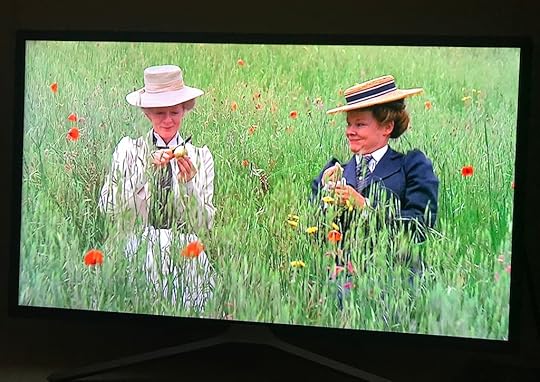

What would we do without A Room with a View? What would we do without books and movies, and poetry, and sewing, rug hooking, cross-stitch, or other creative projects?
I love the passage in which Molly exclaims “Oh, novels! What would I do without you?” She’s just spent an evening with Jane Austen’s Emma. “I love re-reading,” she says, “while trying to pretend I don’t know Emma will end up with Mr. Knightley. The suspense nearly kills me every time.”
I’ll pause, for now, with my new scrapbooking project, and leave you with a photo of a bouquet of tulips that my daughter brought home last week, which brightened our house during some cold and snowy winter days.

February 24, 2023
Reading L.M. Montgomery Together
Would you like to read one (or two) of L.M. Montgomery’s novels with my friend Naomi and me? As I mentioned last Friday in the introduction to the guest post Naomi wrote for my blog, she and I met several years ago through an Anne of Green Gables readalong. A couple of years later, she hosted a readalong for Montgomery’s three “Emily” novels, and not long after that, we co-hosted a readalong for The Blue Castle.
We’ve been talking about reading another Montgomery novel together in the spring. Maybe Jane of Lantern Hill or Kilmeny of the Orchard. Or Pat of Silver Bush and Mistress Pat. If you’d like to join us, please let us know. Which novel(s) would you vote for?


I was sure I had a copy of Kilmeny of the Orchard, but I can’t find it. I know I read it when I was ten or eleven, back when I was completely obsessed with the world of Montgomery’s novels. I do, however, have this copy of “Una of the Garden,” a story Montgomery published in 1908-1909 and later transformed into Kilmeny of the Orchard.

Sometimes I think of this blog as a kind of scrapbook, inspired by the many scrapbooks Montgomery kept, in which she collected poems, stories, and book reviews, along with mementos such as ribbons, concert programs, pressed flowers, and so on.
In that spirit, then, I’ll add to my “scrapbook” some photos of spring flowers, given to me by my sister, who has been taking pictures of crocuses in Bonn, Germany, and my daughter, who was in Washington, DC last weekend.
If you’d like to read more about Montgomery’s scrapbooks, I recommend Carolyn Strom Collins’s article “Cutting and Pasting: What L.M. Montgomery’s Island Scrapbooks Reveal About Her Reading,” in the Journal of L.M. Montgomery Studies. I heard Carolyn present this paper at the L.M. Montgomery International Conference “L.M. Montgomery and Reading” in June of 2018 at the University of Prince Edward Island.
Elizabeth Rollins Epperly, founder of the L.M. Montgomery Institute at UPEI, curated a virtual exhibition that includes scrapbook pages: “Picturing a Canadian Life: L.M. Montgomery’s Personal Scrapbooks and Book Covers.”


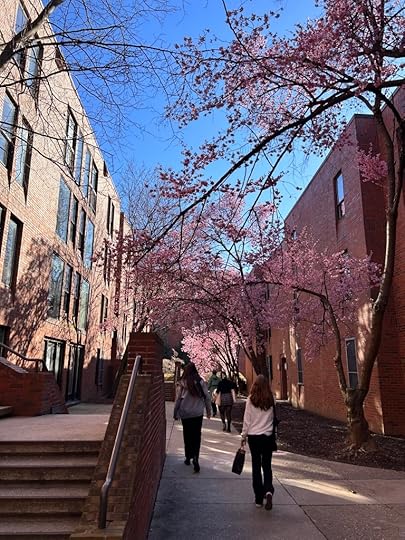
February 17, 2023
Reading Close to Home
It’s a pleasure to introduce this guest post by my friend Naomi MacKinnon, whom I met online several years ago through an Anne of Green Gables readalong hosted by Lindsey Reeder. Naomi lives in Truro, Nova Scotia, about an hour’s drive from where I live, in Halifax. Since that first meeting online, we’ve seen each other in person many times, often at meetings of our local Project Bookmark Reading Circle, where we discuss fiction and poetry with the goal of identifying and recommending short passages set in specific places that could be marked with a Bookmark plaque. (If you’re interested, you can read more about our Reading Circle on the Project Bookmark website.)

Given our shared interests, Naomi and I weren’t surprised when we happened to run into each other at Anne of Green Gables – The Ballet, performed by Canada’s Ballet Jörgen in Halifax in 2019. Naomi attended with her daughters and her mother-in-law, and I was there with my daughter and my mother—and it was a delightful surprise to discover that Naomi’s mother-in-law and my mother have known each other for years. (Yes, it often seems that all of Nova Scotia is one small town….)
In the fall, when I was writing about the way my love of reading has served as an anchor during these last few years of challenges and uncertainty, I decided to ask some of my friends to write guest posts in which they talk about books they’ve read recently and want to recommend to others. Naomi’s is the first in this new series. When I asked her for a bio, she wrote that she’s “the mom of three human kids and five furry ones.” She added, “I have always lived in Nova Scotia, with the exception of the four years I spent in Sackville, NB, studying Biology at Mount Allison University. I love to read, walk, and eat cookies.”
I’m always keen to find out what Naomi’s discussing on her fabulous blog, Consumed By Ink, where she writes about Canadian books, especially those set in Atlantic Canada. Recent posts have featured Ducks, by Kate Beaton (which Barack Obama named as one his favourite books of 2022, and which Mattea Roach of Jeopardy! fame will be defending on Canada Reads this year); Emily Urquhart’s collection of essays on fairy tales and folklore, Ordinary Wonder Tales; and Steven Laffoley’s “irreverent histories” of food and drink in Nova Scotia.
Please help me give a warm welcome to Naomi! Here’s her guest post on “Reading Close to Home.”

When Sarah invited me to write a guest post for her blog I was delighted. I always love the opportunity to talk about good books.
As followers of my blog know, I love reading literature close to home—and, for me, that means Atlantic Canada. I enjoy reading about familiar settings. It makes me feel as though I know the characters intimately, that I might bump into them on the street someday. Or on a ferry, or at the beach, or in a bookstore. I could ask Mrs. Ward how her son is making out. Or I could ask Dot if they’ve gotten any new cats in at the animal shelter. I could go to the piano recital at the seniors’ home up the street and whisper into my friend’s ear about how unprepared Darcy was for his recital this year and be relieved it wasn’t my own child. I could say hello to Herring and Gerry while I’m down at the wharf buying fresh lobster.
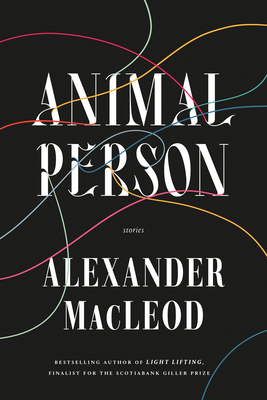
Let’s start with one of Nova Scotia’s best short story writers, Alexander MacLeod, and his newest collection Animal Person. This is a book that Sarah has written about, too, saying, “Line by line, the whole book is brilliant.” Every sentence has been considered carefully to create well-crafted stories. When I think of this collection, I think of two sisters spread-eagled, face-down in the water, all you can hear is the breath through their snorkels. I think of a man using a stranger’s toothbrush then placing it back into the suitcase. I think of young Darcy at his piano recital, worrying about his performance as he sits listening to the others. And I think of a man and his rabbit and their unlikely companionship.

The other short story collection I want to recommend is The Love Olympics by Claire Wilkshire of St. John’s, Newfoundland. This collection is so relatable—it made me laugh and nod my head with recognition. With a strong focus on women, the book is full of memorable characters who weave their way in and out of these stories. I especially liked “The Dinner” in which four women gather together in the evening: women who are tired and looking forward to a much-needed break away from their families; women who are coping with the unpredictable nature of middle-aged hormones; women who have remained friends and supported each other through all their years of motherhood and marriage.

It’s more unusual to come across a good book about a friendship among a group of men. Jim McEwen’s Fearnoch might be stretching the boundaries of what some might consider Atlantic Canadian, but I am claiming it as ours. (McEwen is from a small town outside of Ottawa, which is also where his novel is set, but he graduated from St. John’s Memorial University Master of Creative Writing program and his book is published by St. John’s Breakwater Books.) Fearnoch focuses on three men who grew up together as friends, but many years later wonder if they’re still able to call themselves that. They’re grown now with partners, children, jobs, health issues. This book explores the nature of friendship and how it grows and changes and supports and disappoints and falls short and overcomes. I thought it was beautiful.
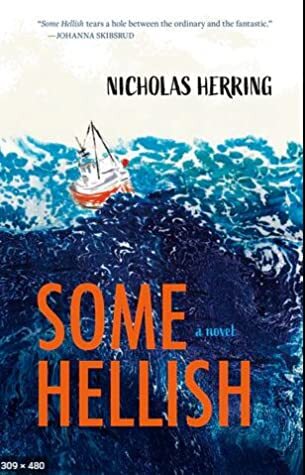
Set in Prince Edward Island where the author is from, Some Hellish, by Nicholas Herring, is another novel I read this year about male friendship—in this case between two men who may not even think of themselves as friends. They spend a lot of time together as lobstermen, but I don’t think they realize how important this time together has become for them. A hard book to read in many ways—as the title indicates—but there’s some humour to lighten things up, and I dare you not to get attached to the characters despite their tendency to make all the wrong choices.
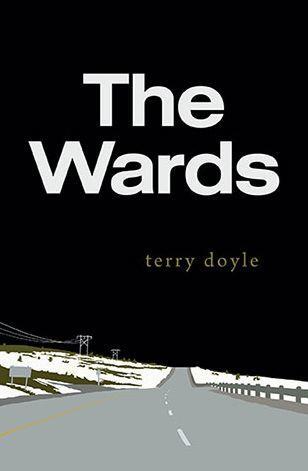
There’s a younger male friendship in The Wards, by Terry Doyle. Although not at the heart of the novel, the friendship helps us to see the family members from an outsider’s perspective. The Wards—who live in St. John’s, NL—are an ordinary family with ordinary challenges, but the characters’ voices bring this book to life—characters you get to know so well that “you’re never surprised by their actions, even when their actions surprise you.” The kind of characters you’ll miss when the story is over.

In a similar vein, The Remembering, by Susan Sinnott, is a story about a mother and her three grown daughters (who also live in St. John’s, and who have possibly passed The Wards on the street or in the frozen foods section of the grocery store). It’s told from the perspective of the family members, with some humour and a lot of compassion. When one of the sisters is assaulted, we see how the situation is handled by the others, and how the incident influences their lives over the course of many years, into the next generation.
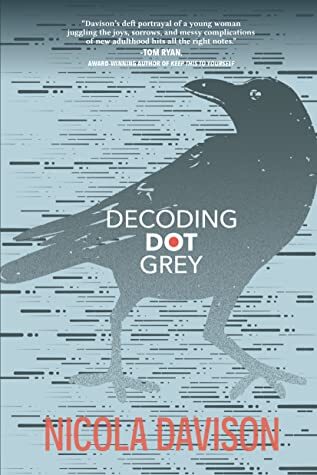
Set in the Halifax area, Decoding Dot Grey, by Nicola Davison, is a story about a family that has dwindled from three down to two, and Dot is a girl who is learning to cope with the loss of a parent. I adored this book. I loved Dot and her dad. I loved the animals with their unique personalities. The animals provide some humour and light moments in a book about grief. A tender story with a lot of heart, gentle humour, and some fun word-play. The world needs more books like this.

I love a good setting. A setting you can picture, even if you have never been there. But even better—for me—is one that I already know and love. Bird Shadows, by Jennie Morrow, takes place close to my hometown of Yarmouth, Nova Scotia. Mavillette—where most of the book is set—is my favourite beach. It felt like we could run for miles on that beach. But the most delightful thing is that I was just as taken with the story as I was with the setting. The book explores themes of faith, family, and feminism, and does it well.

Mavillette Beach

Cape Forchu, the Yarmouth light
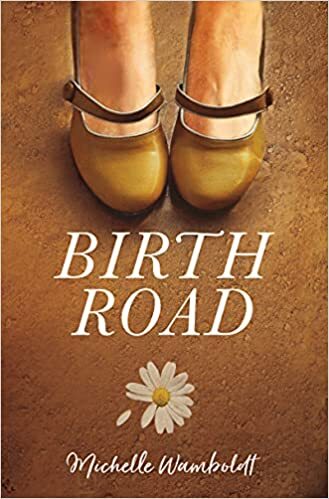
Bird Shadows takes place where I grew up, but Birth Road, by Michelle Wamboldt, takes place where I live now, in Truro. Although the story happens in the 1930s and 40s, the town is still recognizable and it’s fun to compare the accompanying map with what the town looks like now. I liked the familiar setting, and I also liked the fact that the story is a page-turner. At the beginning you learn that Helen is about to give birth, then the story takes you back to her childhood when her father was drunk all the time, her mother was stern, and her only friend was hiding something. Birth Road was inspired by the author’s grandmother.

The library in Truro, which in the 1930s and 40s was the Normal College.
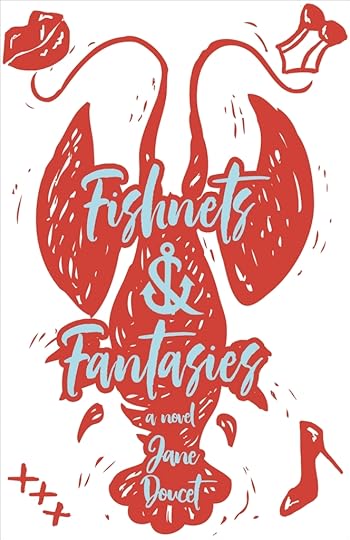
Lastly, the book that made me laugh the most, Fishnets & Fantasies, by Jane Doucet (a Halifax-based author), is a delight from beginning to end. What would people think if someone opened a sex shop in a small, UNESCO World Heritage Site like Lunenburg, NS? Do yourself a favour and find out. It might even make you want to open one yourself!

Lunenburg, Nova Scotia
The best thing about all of these books is the love the authors clearly have for their stories and characters. It fills my heart and sends me straight to my next reading journey in the hopes that it will be just as rewarding.
Happy Reading!

February 10, 2023
Inspired by Pride and Prejudice

What are your favourite Pride and Prejudice-inspired books? With Valentine’s Day coming up, since this novel is one of the great love stories, I thought I’d share a short list of some of my favourite P&P-inspired books. And of course I’d be glad to hear your recommendations.
The first one that comes to mind for me is Bridget Jones’s Diary, which I read, and loved, on a trip to London in the summer of 1997. I also loved Death Comes to Pemberley (2011), by P.D. James, though I remember thinking it seemed, at least in places, more Dickensian than Austenian. I’m a fan of the Cozy Classics board book version of Pride and Prejudice (2012), created by Jack and Holman Wang, and I’ve given it as a present to friends and relatives with newborns more times than I can count. I love the illustrations in Lizzy Bennet’s Diary (2013), written and illustrated by Marcia Williams, and in Goodnight Mr. Darcy (2014), by Kate Coombs, illustrated by Alli Arnold.

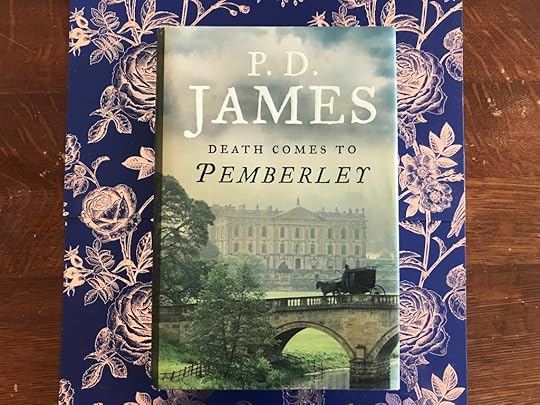
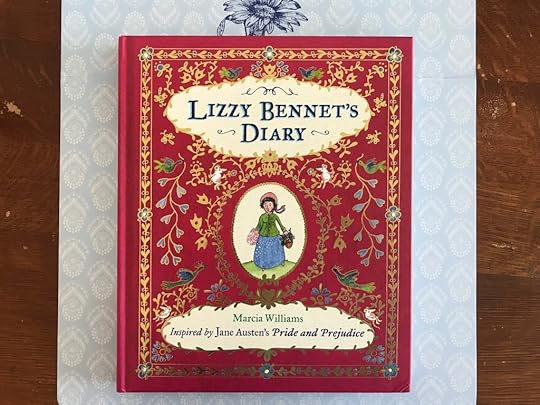

I enjoyed recognizing some elements of character and plot from Pride and Prejudice in Uzma Jalaluddin’s Ayesha at Last (2018), and I admire the way she created new twists and turns in her novel in a way that kept me guessing right up until the last chapters. I won’t give away the plot twists here, but I can say it’s easy to spot Lady Catherine as an inspiration for Farzana, the mother of the Darcy-inspired character: Farzana tells the heroine, Ayesha, that when her son Khalid “spoke about the teacher who was helping him plan the conference, I knew it was time for him to get married. Before he was duped by a pathetic spinster pretending to be more than she was.” Mr. Collins makes an appearance as “a life coach for wrestlers” who thinks of himself as “a doctor of the heart” and offers “motivational mantras” in times of tension. And there are echoes of Mrs. Bennet’s obsession with “the clothes, the wedding clothes!” in the words of Samira Aunty: “We had so much fun picking out her wedding lengha. It cost five thousand dollars and is being shipped from Pakistan direct!” I’m really looking forward to reading Jalaluddin’s new novel, Much Ado About Nada, which will be published in June.

Some of the other Pride and Prejudice-inspired novels I’ve enjoyed include Definitely Not Mr. Darcy (2011) and Undressing Mr. Darcy (2013), both by Karen Doornebos; Longbourn (2013), by Jo Baker; Pride (2018), by Ibi Zoboi; The Clergyman’s Wife (2019), by Molly Greeley; and Unmarriageable (2020), by Soniah Kamal.
I know there are many more—a quick search on Goodreads tells me there are at least 520 books inspired by Pride and Prejudice. What titles would you recommend?


P.S. I thought I’d share some early spring flowers with you. My sister Bethie took the pictures of snowdrops and flowering quince in Bonn earlier this week. The witch hazel was a present from my friends Hugh and Sheila Kindred, who came to my house for tea yesterday. This little bouquet is a nice spot of colour on a gloomy, snowy, slushy day in Halifax.



January 28, 2023
Living in Pride and Prejudice
Pride and Prejudice was published 210 years ago today, by Thomas Egerton, and Jane Austen earned £110 by selling the copyright. She had written to her friend Martha Lloyd in November of 1812 that “P. & P. is sold.—Egerton gives £110 for it.—I would rather have had £150, but we could not both be pleased, & I am not at all surprised that he should not chuse to hazard, so much.”
The day after the novel was published, Jane wrote, famously, to her sister Cassandra to say she had received her copy: “I want to tell you that I have got my own darling Child from London.” While preparing her first novel, Sense and Sensibility, for publication in 1811, she had used a similar metaphor: “No indeed, I am never too busy to think of S&S,” she wrote to Cassandra. “I can no more forget it, than a mother can forget her sucking child.”
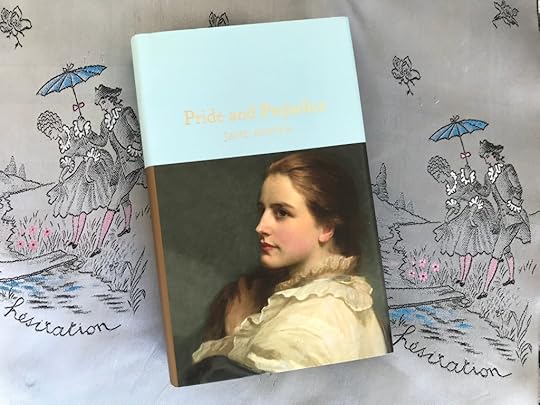
I’m sure I’ve said more than once on this blog that Pride and Prejudice is not only my favourite Austen novel, but my favourite novel of all time. Even though my affection for Persuasion increases every time I reread it, Pride and Prejudice is still my favourite, with Persuasion a close second. My sister Bethie and I have been talking about why we love Pride and Prejudice so much. Among the many reasons is the fact that the language of Jane Austen’s characters has become part of our everyday life. It’s as if we’re living in the novel. I don’t mean we’re imagining that the pattern of our lives follows the same plot. It’s that we often think in and with Austen’s sentences and we quote her words, sometimes seriously, sometimes as a joke.
We do this with Persuasion and other Austen novels, and with fiction and poetry by other writers (and with film adaptations). I sometimes insist, with Mary Musgrove, that “my sore throats, you know, are always worse than anybody’s,” or, with Fanny Price, that “We have all a better guide in ourselves, if we would attend to it, than any other person can be,” and I wrote recently about Bethie’s excellent imitation of Mr. Beebe from A Room with a View : “If Miss Honeychurch ever takes to live as she plays it will be very exciting, both for us and for her.”
But the words of Pride and Prejudice come up in conversation more often. I expect that’s partly because so many members of our extended family have seen the 1995 A&E mini-series several times, but I think it’s also because of “the playfulness & Epigrammatism of the general stile”—to borrow the words Jane used in a letter to Cassandra, a few days after Pride and Prejudice was published.
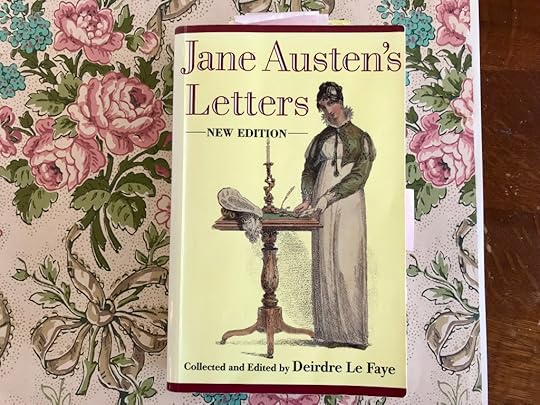
This edition of Jane Austen’s letters was a present from my late friend Janet. She and I visited the Jane Austen Centre in Bath more than twenty years ago, and since we both wanted to own the Letters, we bought copies for each other from the gift shop.
If you’re a fan of Pride and Prejudice, as Bethie and I are, do you find yourself thinking and speaking in Jane Austen’s sentences? If you do, I’d love to hear about the lines that resonate for you.
Here are some of the sentences on my list:
“You have no compassion on my poor nerves.”
“We dine with four and twenty families.”
“Do you prefer reading to cards?”
“I am not a great reader, and I have pleasure in many things.”
“I cannot comprehend the neglect of a family library in such days as these.”
“Let the other young ladies have time to exhibit.”
“Happiness in marriage is entirely a matter of chance.”
“If you mention my name at the Bell, you will be attended to.”
“I am excessively attentive to all those things.”
“If I had ever learnt, I should have been a great proficient.”

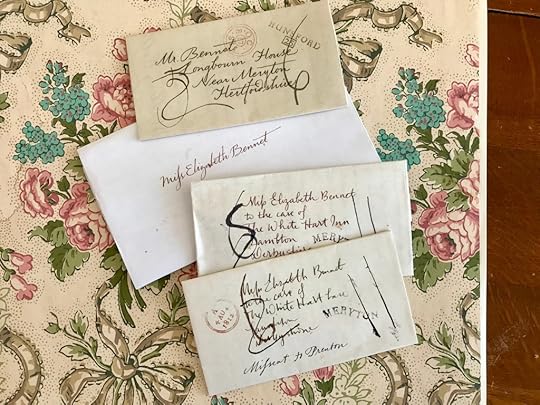
This lovely edition of Pride and Prejudice, curated by Barbara Heller, was a present from my friend Lisa in the first year of the pandemic. She and I have continued the tradition Janet and I started long ago, of giving each other identical copies of books we’d both like to add to our collections.
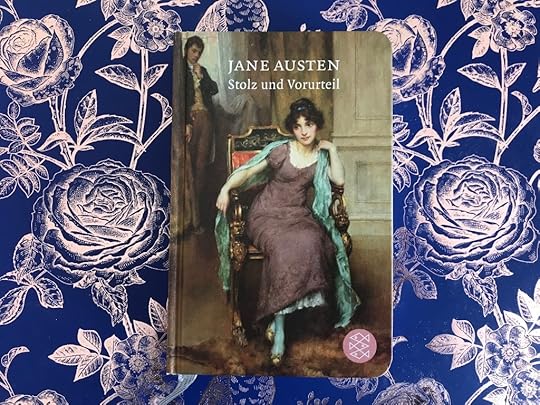
Bethie gave me this translation of Pride and Prejudice. I wish I could remember more of what I learned in my high school and university courses in German, so I could read it properly. But alas, though I did study German, I am not a great proficient.
If you enjoyed this post, you might also be interested in what I wrote for the 200th anniversary of Pride and Prejudice in 2013. “Jane Austen’s ‘Darling Child’ Meets the World” continues to be one of the most popular posts on my blog.
In 2013, I also wrote a series of blog posts on Pride and Prejudice at 200.
P.S. Bethie suggested the title “Living in Pride and Prejudice.” Thanks, B!
P.P.S. A note on the fabric and paper backgrounds I chose for these photos, for my friend Marianne—hi Marianne!—and anyone else who’s curious: the “hesitation” scarf was a gift from my husband and daughter, who found it last summer in a vintage clothing shop in London; the scrap of floral wallpaper is from my childhood bedroom; and the blue background in the photo of Stolz und Vorurteil is from a set of Jane Austen-themed folders my friend Lisa gave me for Christmas.
P.P.P.S. John Mullan wrote a wonderful short essay in honour of the 210th anniversary of Pride and Prejudice, for Jane Austen’s House Museum. He talks about the brilliance of Jane Austen’s dialogue, right from the first chapter in which we hear Mr. and Mrs. Bennet speaking. I like the way he points out that the “opening chapter of Pride and Prejudice is even daring in its omission. Elizabeth’s entrance is held back. Austen created the most irreverent and intellectually lively heroine the English novel had known, but kept her away from her opening scene.”
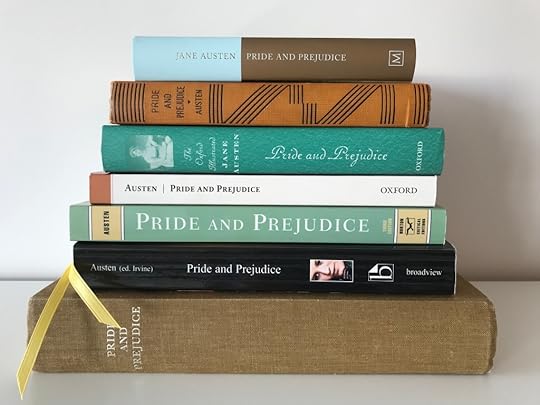
January 20, 2023
Rereading Persuasion, Part 2
I don’t think I’ll ever tire of reading about second chances. I finished rereading Persuasion, and I’ve been thinking about the fact that in addition to giving her heroine a second chance at happiness, Jane Austen gave herself a second chance at writing the ending of the novel. Apparently dissatisfied with her draft of the final chapters (which you can read here, if you haven’t come across them before), she wrote a new version, which includes the famous debate between Anne Elliot and Captain Harville over whether men or women are more constant in their devotion to the one they love.
Near the end of their conversation, Harville says, “I do not think I ever opened a book in my life which had not something to say upon woman’s inconstancy. Songs and proverbs, all talk of women’s fickleness. But perhaps you will say, these were all written by men.”
And Anne replies, “Perhaps I shall. Yes, yes, if you please, no references to examples in books. Men have had every advantage of us in telling their own story. Education has been theirs in so much higher a degree; the pen has been in their hands. I will not allow books to prove anything.”
The revised chapters also include The Letter, which has made many a reader swoon. “You pierce my soul. I am half agony, half hope. Tell me not that I am too late, that such precious feelings are gone forever….”
Anne gets a second season of youth and beauty, as well as a second chance at happiness. I love reading about the way her “bloom” returns, during her visit to the seaside at Lyme:
“She was looking remarkably well; her very regular, very pretty features, having the bloom and freshness of youth restored by the fine wind which had been blowing on her complexion, and by the animation of eye which it had also produced.”
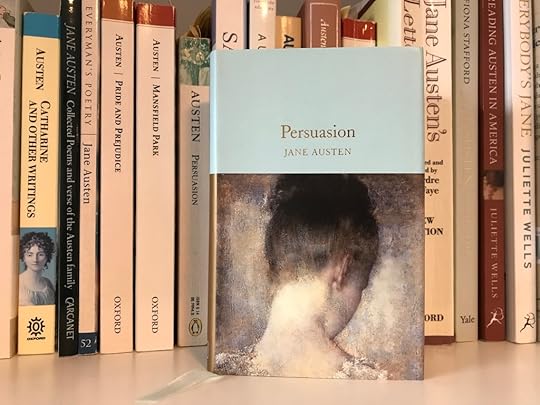
I always enjoy finding references to Jane Austen’s novels in contemporary fiction. I’d love to hear about examples you’ve found in your own reading, if you’d like to share. A few years ago, I wrote about finding Elinor and Marianne Dashwood in Emma Straub’s Modern Lovers, Jeanne Birdsall’s The Penderwicks on Gardam Street, and Gail Honeyman’s Eleanor Oliphant is Completely Fine (in a blog post entitled “Elinor and Marianne”).
My guess would be that Pride and Prejudice and its characters turn up in contemporary novels more often than the other Austen novels do. A character inspired by Lady Catherine de Bourgh, for example, appears in Jennifer Robson’s 2015 novel After the War is Over, which is set in England in 1919. The heroine, Charlotte Brown, a former governess and nurse, receives an unexpected call from the imperious Lady Cumberland, who says her son has broken his engagement because of “some strange sort of attachment” to Charlotte. “He’s always had an affinity for those who are beneath him,” she claims.
When Charlotte asks if Lady Cumberland intends to “warn [her] off, à la Lady Catherine de Bourgh,” Lady Cumberland says she doesn’t know anyone by that name. Charlotte considers explaining the reference to Pride and Prejudice, but decides not to, because “Lady Cumberland had never approved of novels, and particularly not ones written by women.” Robson’s heroine responds to Lady Cumberland’s accusations with the same lively spirit as Elizabeth Bennet.
It’s a wonderful scene, with echoes of Jane Austen—Lady Cumberland calls Charlotte an “Insolent girl,” just as Lady Catherine calls Elizabeth an “Obstinate, headstrong girl”—and yet by the end, the relationship between the two women in Robson’s novel has changed significantly, as Lady Cumberland finds herself asking Charlotte for help. Her son has returned from the Great War a broken man, both physically and psychologically, and she realizes that Charlotte’s training and experience at the Special Neurological Hospital for Officers in Kensington might help him recover. Robson draws on Pride and Prejudice for inspiration, and creates something entirely new.
Charlotte Brown, like so many of us, turns to Jane Austen to help her understand her own life, whether she’s interpreting character or reading fiction in a time of crisis. When she and the other women at her boarding house gather in the sitting room for safety during a riot, Charlotte tries to persuade herself that she can learn to be happy and strong on her own, that she will survive the challenges that lie ahead of her. The novel she picks up to read to her friends is “a much-loved copy of Persuasion.” “Shall I read to you all?” she asks. “I think I have just the book for the occasion.”
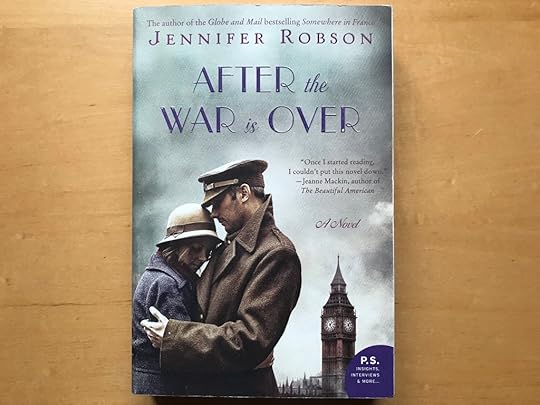
After I finished rereading Persuasion, I went back to reread the guest post my friend Maggie Arnold wrote for the blog series I hosted in 2018, in honour of the 200th anniversary of the publication of Northanger Abbey and Persuasion.
Maggie writes that when Anne and Captain Wentworth first fell in love, “he was a young naval officer who had not yet proved himself—his early promise and energetic temperament were as yet untried.” And “Anne herself was inexperienced, a weakness which only time could correct, as she comes to know more people and to witness their failures and successes.” Eventually, she “can clearly see the path of her desire as the life to which she can commit herself, now with the maturity of ‘a collected mind.’ She knows her own worth, and others acknowledge it, too.”
I think Maggie’s right that this process is central to the novel. The romance is important, but so is the education of the heroine, through which she “comes to know her place in the world.” If you’d like to read more, you can find Maggie’s guest post here: “What Women Most Desire: Anne Elliot’s Self-discovery.”
And here’s the link to Rereading Persuasion, Part 1, if you missed it.
Next week, let’s talk more about Pride and Prejudice, shall we? Saturday, January 28, 2023 marks 210 years since the day it was first published.
I found some photos from my visit to Lyme with my cousin Honor, about twenty years ago. During the two years that I was a postdoctoral fellow in England, she very kindly took me to many literary sites, including Milton’s Cottage, William Morris’s Kelmscott Manor, Samuel Johnson’s Birthplace Museum in Lichfield, and many more. We had such a wonderful time that day in Lyme—and I’d love to visit again. (Also—I loved that red coat. Wish I still had it.)

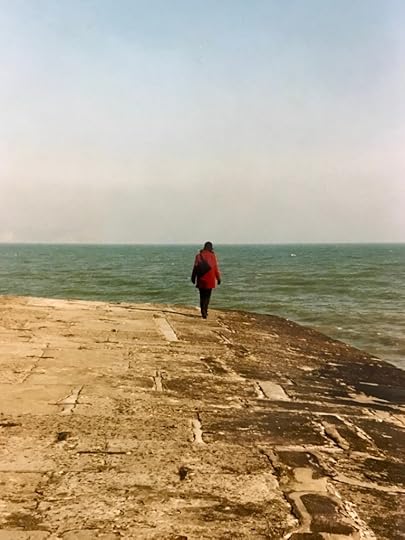

A postscript: Have you heard about Uzma Jalaluddin’s new novel, Much Ado About Nada, which is inspired by Persuasion? I just read a CBC article about it this morning—“Uzma Jalaluddin takes on Jane Austen’s Persuasion in her latest modern Muslim retelling of a rom-com classic”—and I enjoyed the excerpt that was included, so I’ve pre-ordered a copy. The publication date is June 13th.
January 6, 2023
Rereading Persuasion
After my sister and I watched the 1995 adaptation of Persuasion in December, I decided to reread the novel again. I’ve been thinking it works well to read it in January because it’s about second chances and new beginnings.

I love the passage in which Jane Austen tells us Anne Elliot “had been forced into prudence in her youth” and “learned romance as she grew older—the natural sequel of an unnatural beginning” (Volume 1, Chapter 4). And I love the marginal note next to it in a first edition, which may have been written by Jane’s sister Cassandra: “Dear, Dear Jane! This deserves to be written in letters of gold.”
I like the speed with which Anne’s sister Mary recovers her spirits when Anne comes to visit her at Uppercross Cottage: “She could soon sit upright on the sofa, and began to hope she might be able to leave it by dinner-time. Then, forgetting to think of it, she was at the other end of the room, beautifying a nose-gay; then, she ate her cold meat; and then she was well enough to propose a little walk” (Volume 1, Chapter 5).
And I like the description of the Musgroves, who, “like their houses, were in a state of alteration, perhaps of improvement” (Volume 1, Chapter 5). This comparison also seems appropriate for January, a time when so many of us attempt to make alterations, perhaps improvements, in our lives.
I’m fascinated by the scene in which Anne encounters her former fiancé, Captain Wentworth, for the first time in eight years, and tries to reason with herself that since so much time has passed, she ought not to feel so much:
How absurd to be resuming the agitation which such an interval had banished into distance and indistinctness! What might not eight years do? Events of every description, changes, alienations, removals,—all, all must be comprised in it; and oblivion of the past—how natural, how certain too! It included nearly a third part of her own life.
Alas! with all her reasonings, she found, that to retentive feelings eight years may be little more than nothing.
(Volume 1, Chapter 7)

I’ve underlined and memorized many passages from this novel over the years, and I think my all-time favourite is probably Mrs. Croft’s response to Captain Wentworth when he says he “hate[s] to hear of women on board” a naval vessel:
“But I hate to hear you talking so, like a fine gentleman, and as if women were all fine ladies, instead of rational creatures. We none of us expect to be in smooth water all our days.” (Volume 1, Chapter 8)

I took this photo of Halifax Harbour and McNabs Island on a walk at Point Pleasant Park earlier this week.
When I visit Point Pleasant I always think of Jane’s brother Captain Charles Austen and his wife Fanny, who sailed past McNabs Island into Halifax Harbour in 1809 and again in 1810 and 1811, when he was serving on the North American Station. And of her brother Admiral Sir Francis Austen, who lived at Admiralty House in Halifax between 1845 and 1848, when he was Commander-in-Chief of the North American and West Indies Station.
Fanny Austen often sailed with Charles and endured the hazards of several voyages, including a snowstorm in late November 1809, when they were sailing out of Halifax on board HMS Indian on their way back to Bermuda. My friend Sheila Johnson Kindred has written about the storm in her splendid book Jane Austen’s Transatlantic Sister: The Life and Letters of Fanny Palmer Austen: “Just out of Halifax the Indian met ‘strong gales with sleet and snow.’ By the evening the ‘gale increased’ and ‘the ship was labouring and shipping heavy seas.’” Fanny was caring for her first child, Cassy, who was eleven months old, and she was almost seven months pregnant with her second child. The journey must have been extremely difficult. “Imagine Fanny’s relief,” Sheila says, “when land was sighted and they ‘made all sail’ for St David’s Head, Bermuda, arriving in St George’s on 12 December after a harrowing voyage of fifteen days, almost twice as long as the journey usually took.”

If you’d like to know more about Charles and Fanny Austen, Francis Austen, and their families, and the places they visited when they were in Halifax, you’ll find more details in the walking tour Sheila and I created a few years ago when the Jane Austen Society (UK) held a conference here.




